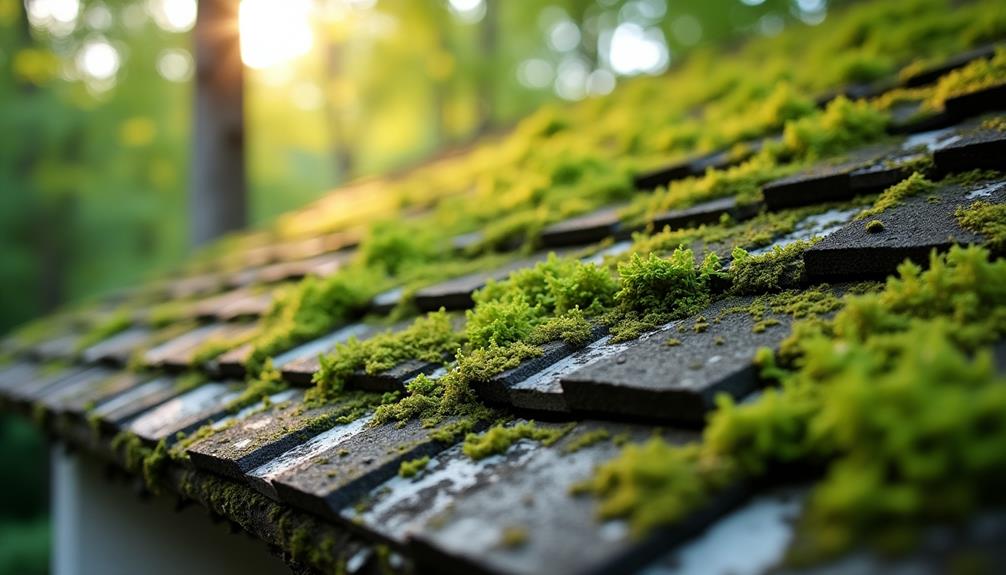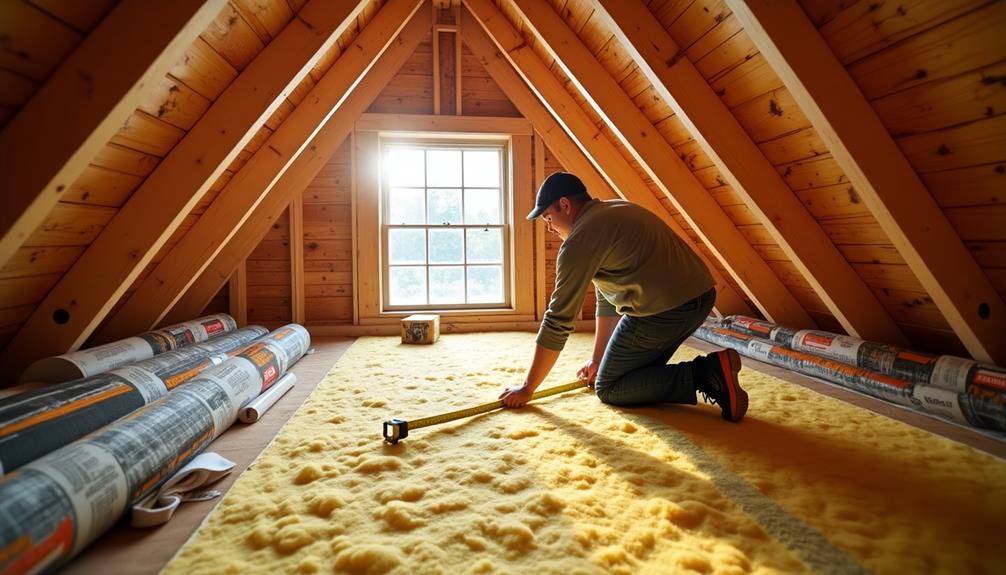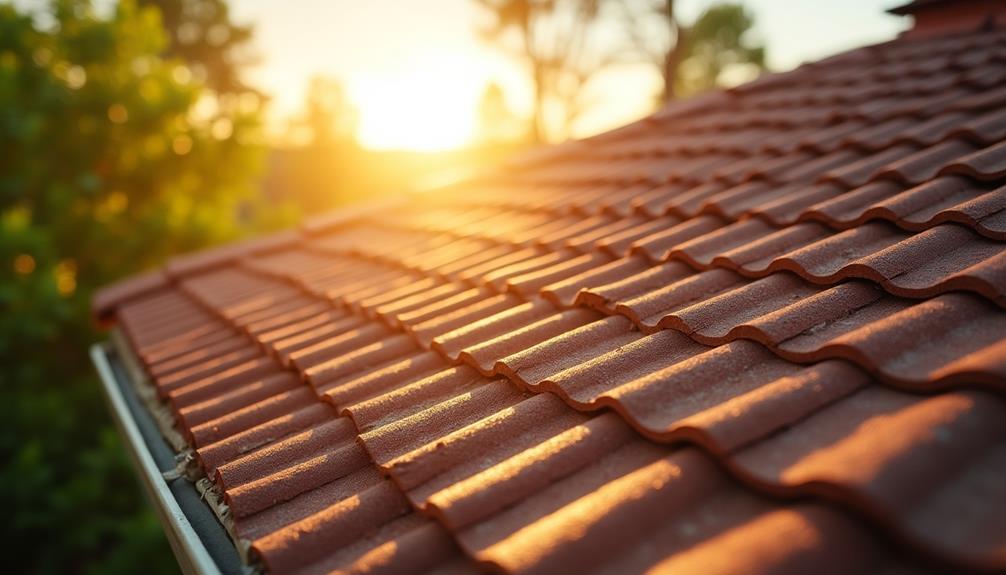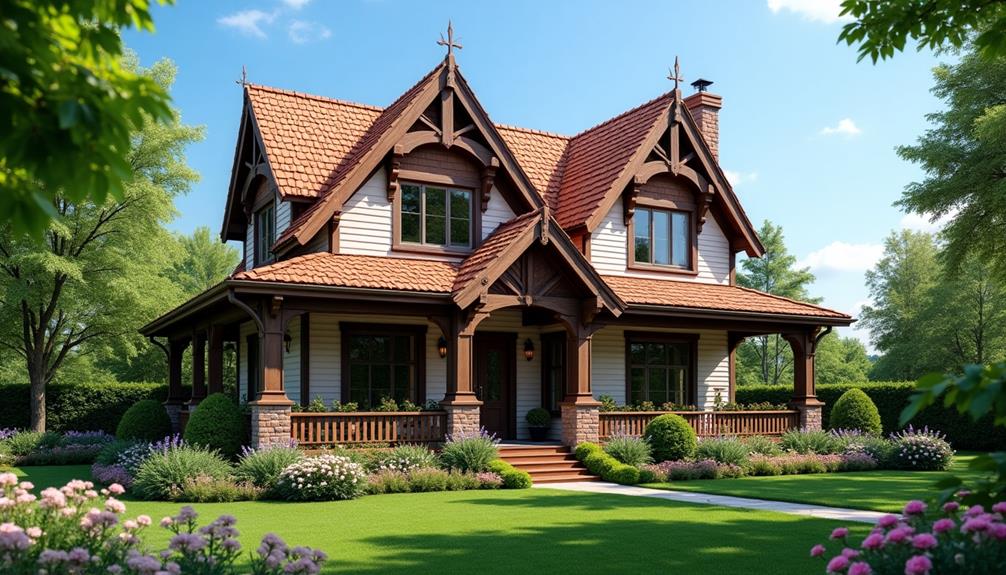To effectively deal with roof moss and algae, start by identifying the affected areas, typically on damp, shaded sections. Regularly trim overhanging branches to increase sunlight and reduce moisture retention. Use specialized cleaning solutions or low-pressure washing to remove existing growth, ensuring safe practices are followed. It's crucial to maintain gutters to prevent water backup and debris accumulation. Additionally, consider applying moss and algae-resistant treatments every few years for prolonged protection. Regular inspections, ideally twice a year, will help catch issues early. For deeper insights into tackling stubborn growth, there are several strategies worth exploring next.
Understanding Roof Moss and Algae
Roof moss and algae are common issues that can compromise the integrity of your roofing system. Understanding their biology is crucial for effective management.
Moss is a non-vascular plant that thrives in damp, shaded environments. Its biology involves a simple structure with no roots, absorbing water and nutrients directly from the air. This allows moss to spread rapidly, potentially lifting shingles and causing leaks.
Algae, primarily blue-green or green varieties, are microorganisms that flourish in warm, humid conditions. Their lifecycle consists of two main phases: a vegetative phase, where they multiply and colonize surfaces, and a reproductive phase, where they release spores to propagate. Algae can create unsightly streaks on your roof and contribute to material degradation over time.
Both moss and algae thrive in areas with poor sunlight, moisture retention, and organic debris. By understanding their biology and lifecycle, you can take proactive steps to prevent growth.
Regular maintenance, such as trimming overhanging branches and cleaning gutters, can help minimize the conditions conducive to moss and algae proliferation, protecting your roofing system's longevity and functionality.
Identifying Signs of Growth
To identify moss and algae growth on your roof, look for visual indicators like dark streaks or green patches.
These signs often thrive in damp, shaded areas, making environmental factors crucial in their development.
Regularly inspecting your roof can help you spot these issues early and take appropriate action.
Visual Indicators of Growth
Often, homeowners overlook the subtle signs of moss and algae growth on their roofs until it becomes a more significant issue. By being vigilant, you can identify these visual indicators early on.
Look for patches of green or black, which signal potential algae colors, indicating that growth has begun. Algae typically appears as dark streaks or spots, while moss types tend to create thicker, more textured mats that can trap moisture.
Check the north-facing areas of your roof, as these spots often receive less sunlight and are more prone to moss and algae growth. If you see any discoloration or fuzzy patches on your shingles, it's a sign you need to take action.
Additionally, examine the roof's edges and valleys where debris accumulates, as these areas create a conducive environment for growth.
Keep an eye on the gutters too; if they're clogged with moss or algae debris, it's a clear indicator that your roof may be affected.
Environmental Factors Contributing
Several environmental factors contribute to the growth of moss and algae on your roof, making it crucial to understand their impact. The climate impact in your area plays a significant role; regions with high humidity and frequent rainfall create ideal conditions for these organisms.
When moisture retention occurs, especially in shaded areas of your roof, it fosters a perfect environment for moss and algae to thrive. Trees or buildings that block sunlight increase moisture levels, as they prevent drying. If you notice that your roof remains damp for extended periods, it's a clear sign that moisture retention is supporting growth.
Furthermore, roof materials can influence susceptibility; porous surfaces are more likely to harbor these organisms. Temperature also matters. Warmer climates can accelerate growth, while cooler temperatures may slow it down but won't eliminate it entirely.
Pay attention to microclimates on your property as well; areas that retain moisture longer can become hotspots for moss and algae.
Causes of Moss and Algae
A variety of factors contribute to the growth of moss and algae on roofs, primarily moisture and shade. When your roof remains consistently damp due to rain, humidity, or poor drainage, it creates an ideal environment for these organisms to thrive.
Moss types, such as *Bryophyta*, often prefer shaded areas, where sunlight is limited, while various algae species, including *Chlorococcum*, can flourish in both sun and shade.
Roof materials also play a role; porous surfaces retain moisture longer, promoting growth. If your roof is covered with debris like leaves and dirt, it further traps moisture and provides nutrients for moss and algae.
Additionally, the orientation of your roof can affect exposure to sunlight. North-facing slopes generally receive less sunlight, making them more susceptible to moss and algae growth.
Lastly, nearby trees can cast shade and drop organic matter, enhancing the problem. By understanding these causes, you can better assess your roof's condition and take preventative measures.
Keeping your roof well-maintained will reduce the likelihood of moss and algae taking hold.
Cleaning Methods for Removal
To effectively combat moss and algae growth on your roof, employing the right cleaning methods is vital. First, consider using chemical treatments specifically designed for roof cleaning. These products often contain solutions that eliminate moss and algae without damaging your shingles.
Apply the treatment according to the manufacturer's instructions, usually involving a simple spray application. It's essential to allow the chemicals time to work—typically 15 to 30 minutes—before rinsing.
Alternatively, pressure washing can be an effective method for removing stubborn moss and algae. However, you need to take precautions to avoid damaging your roof. Use a low-pressure setting, ideally below 1200 PSI, and maintain a distance of at least 6 feet from the surface.
This technique can effectively dislodge debris and growth but may require multiple passes for complete removal.
When cleaning, always wear appropriate safety gear, including gloves and eye protection, to safeguard yourself from chemicals and debris.
After cleaning, ensure your roof is dry to minimize the risk of regrowth. Choosing the right method will keep your roof looking clean and prolong its lifespan.
Preventative Measures to Consider
To prevent moss and algae growth on your roof, you need to implement a few key measures.
Regular roof inspections help you catch issues early, while proper gutter maintenance ensures water flows freely, reducing dampness.
Additionally, trimming overhanging branches will minimize shade, allowing sunlight to dry the roof effectively.
Regular Roof Inspections
Regular roof inspections are essential for maintaining the integrity of your home and preventing moss and algae growth. By keeping a close eye on your roof's condition, you can identify potential issues before they escalate into costly repairs. Schedule inspections at least twice a year, ideally in spring and fall, to ensure you're addressing seasonal challenges.
This inspection frequency allows you to monitor debris accumulation, moisture retention, and any signs of wear that could promote moss and algae proliferation.
During your inspections, check for cracked or missing shingles, damaged flashing, and areas where water may pool. These factors can contribute to roof maintenance problems and create an environment conducive to moss and algae growth.
Also, pay attention to shaded areas, as these are often more susceptible to moisture buildup.
If you notice any irregularities, act quickly to address them. Keeping your roof in good condition won't only enhance its lifespan but also improve your home's overall aesthetic appeal.
Regular inspections, combined with prompt maintenance, will significantly reduce the likelihood of moss and algae taking hold, preserving your roof's functionality and appearance.
Proper Gutters Maintenance
How can you ensure that your gutters effectively protect your roof from moss and algae growth? Proper gutter maintenance is essential to prevent water buildup, which can encourage these unwanted organisms.
Regular gutter cleaning is your first line of defense. Aim to clean your gutters at least twice a year, or more frequently if you have overhanging trees. This removes leaves, twigs, and other debris that can block water flow.
Next, focus on downspout maintenance. Ensure that downspouts are clear and direct water away from your foundation and roof. You can use a plumber's snake to remove stubborn clogs.
Additionally, consider installing downspout extensions to guide water further away from your home, reducing the chances of water pooling around your roofline.
Trim Overhanging Branches
Trimming overhanging branches is a crucial step in preventing moss and algae growth on your roof. When tree branches hang too close, they create shade and trap moisture, which provides the perfect environment for these unwanted organisms.
Regular tree trimming ensures that branches are kept at a safe distance from your roof, allowing sunlight to reach its surface and promoting faster drying after rain.
In addition to enhancing sunlight exposure, branch removal can also prevent leaves and debris from accumulating on your roof. This debris can hold moisture and contribute to the growth of moss and algae.
By maintaining a clear zone around your roof, you significantly reduce the chances of these issues developing. Aim to trim branches at least 6 feet away from your roofline. This distance helps maximize sunlight and airflow.
When performing tree trimming, use sharp tools for clean cuts, and consider hiring a professional for larger branches to ensure safety and compliance with local regulations.
Choosing the Right Products
Selecting the right products for tackling roof moss and algae is crucial for effective treatment and long-term prevention. You'll want to choose a solution that combines product effectiveness with safety for your home and the environment.
Start by looking for specialized roof cleaning solutions designed specifically for moss and algae removal. Many of these products contain ingredients that break down the growth without damaging your roofing materials.
Consider eco-friendly options like vinegar or baking soda, which can be effective in killing moss and algae without introducing harsh chemicals into your surroundings. If you prefer commercial products, look for those labeled as biodegradable and non-toxic. These often provide a balance between efficacy and environmental safety.
Read product reviews and check for certifications to ensure you're selecting a high-quality solution. Always follow the manufacturer's instructions for application to maximize effectiveness.
Additionally, some products may require repeated applications for optimal results, so factor that into your decision. By choosing the right products, you not only address the current moss and algae problem but also help prevent future growth, keeping your roof healthy and looking its best.
When to Call a Professional
Recognizing when to call a professional for roof moss and algae removal can save you time and prevent potential damage to your roofing system. If you notice extensive growth of moss or algae that covers a significant portion of your roof, it's time to seek professional services. These organisms can trap moisture, leading to wood rot and other structural issues.
When you're unsure about the safety of climbing on your roof or lack the necessary equipment, it's wise to consult an expert. Professionals are trained to handle such tasks efficiently and safely, minimizing the risk of accidents or further damage.
If you've attempted DIY methods without success or if your roof shows signs of deterioration, don't hesitate to reach out for help.
Additionally, if your roof is steep or has multiple levels, the risks increase, making professional intervention even more critical. Regular roof maintenance is essential for long-term health, and sometimes that means calling in experts who can assess the situation accurately and apply the right treatments.
Regular Maintenance Tips
Regular maintenance is crucial for preventing roof moss and algae growth. To start, inspect your roof at least twice a year, ideally in spring and fall. Look for signs of moss or algae and take immediate action for effective moss removal.
If you notice any growth, use a low-pressure washer or a soft brush to gently scrub the affected areas. Avoid harsh chemicals that can damage your roofing material.
Keep your gutters clean and free of debris to ensure proper water drainage. Clogged gutters can lead to water pooling, creating an ideal environment for moss and algae to thrive.
Additionally, trim back overhanging branches to increase sunlight exposure on your roof; sunlight helps inhibit growth.
Consider applying a moss and algae-resistant treatment every few years. These treatments can provide lasting protection and simplify future maintenance.






